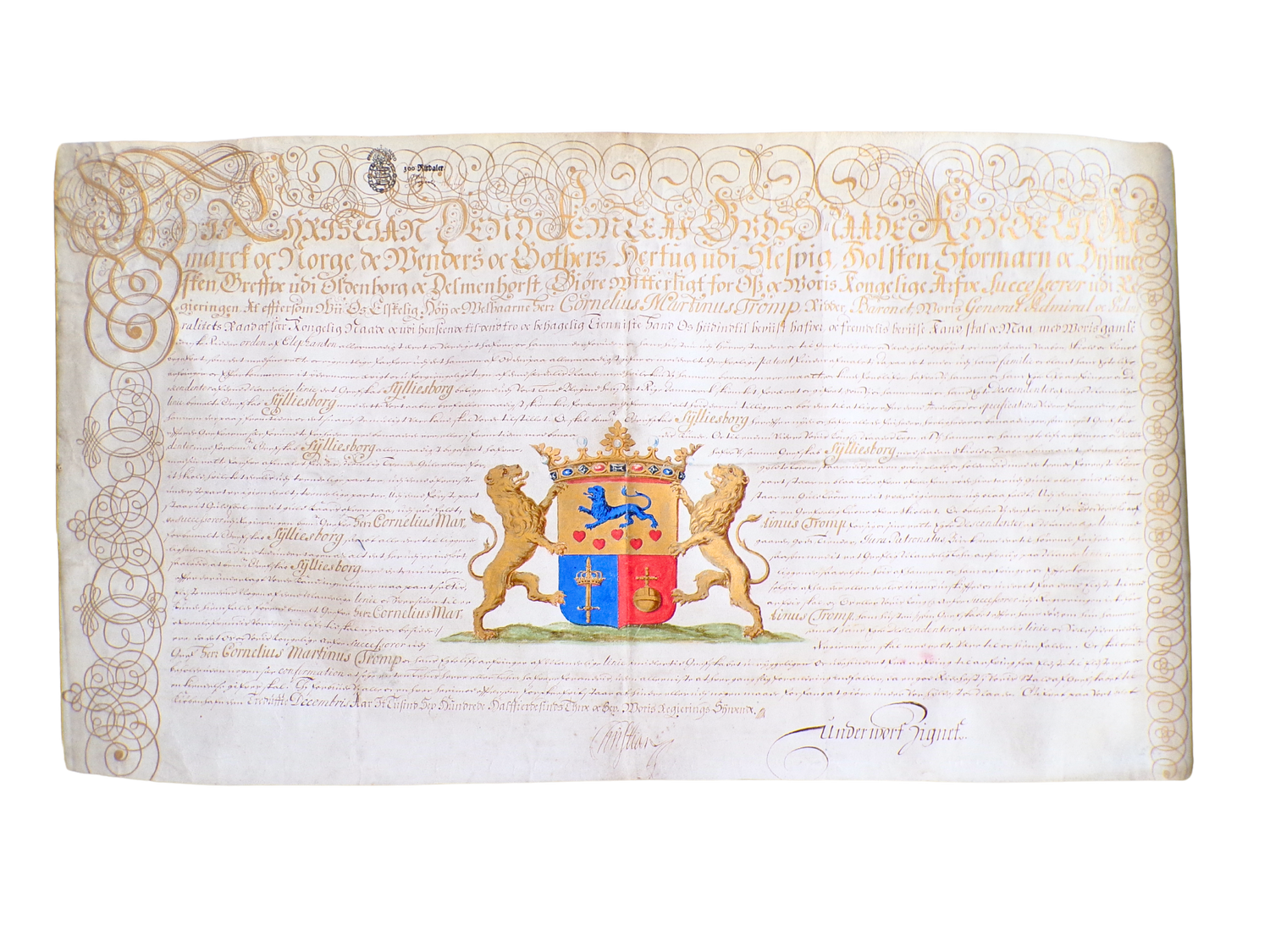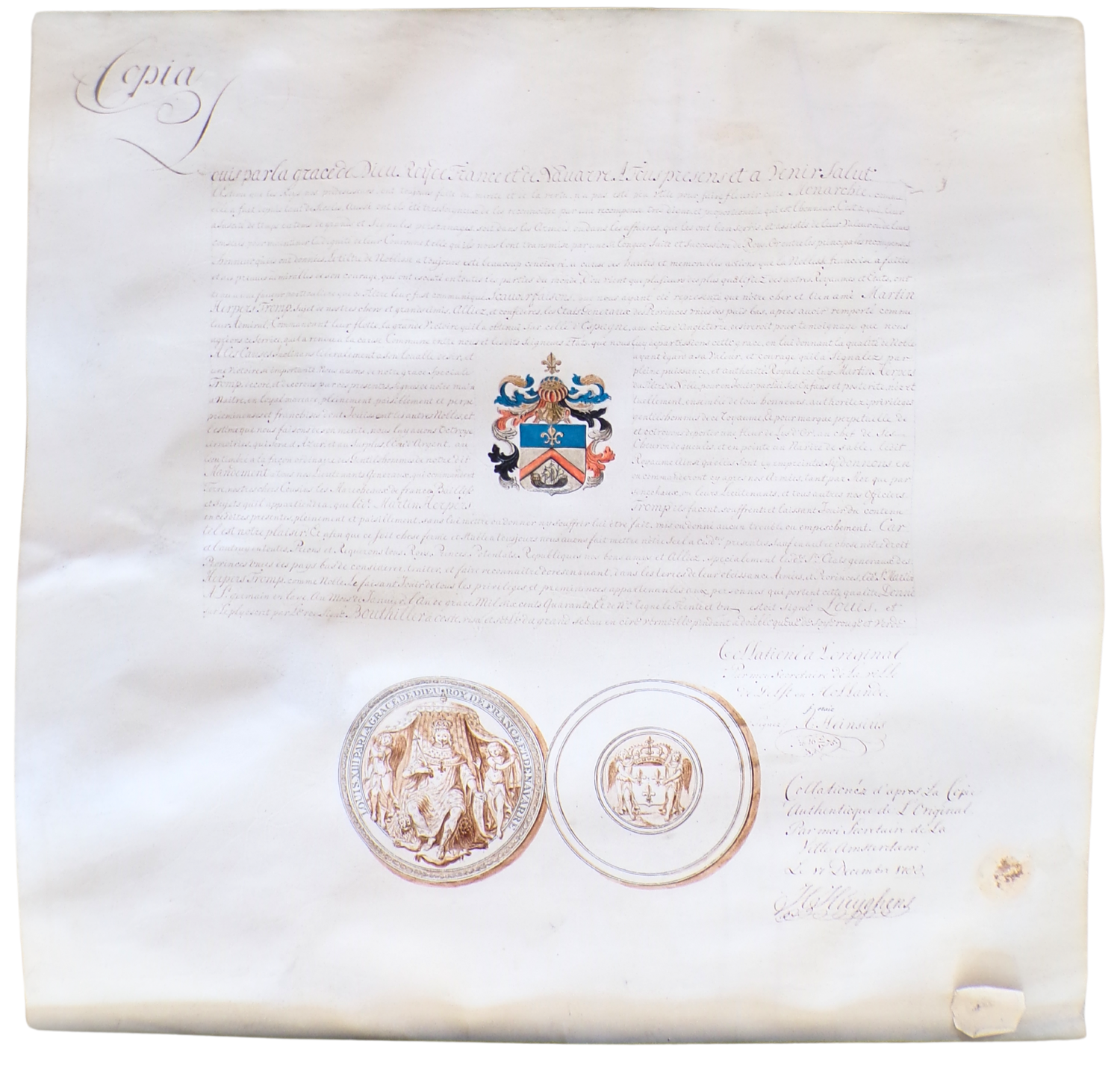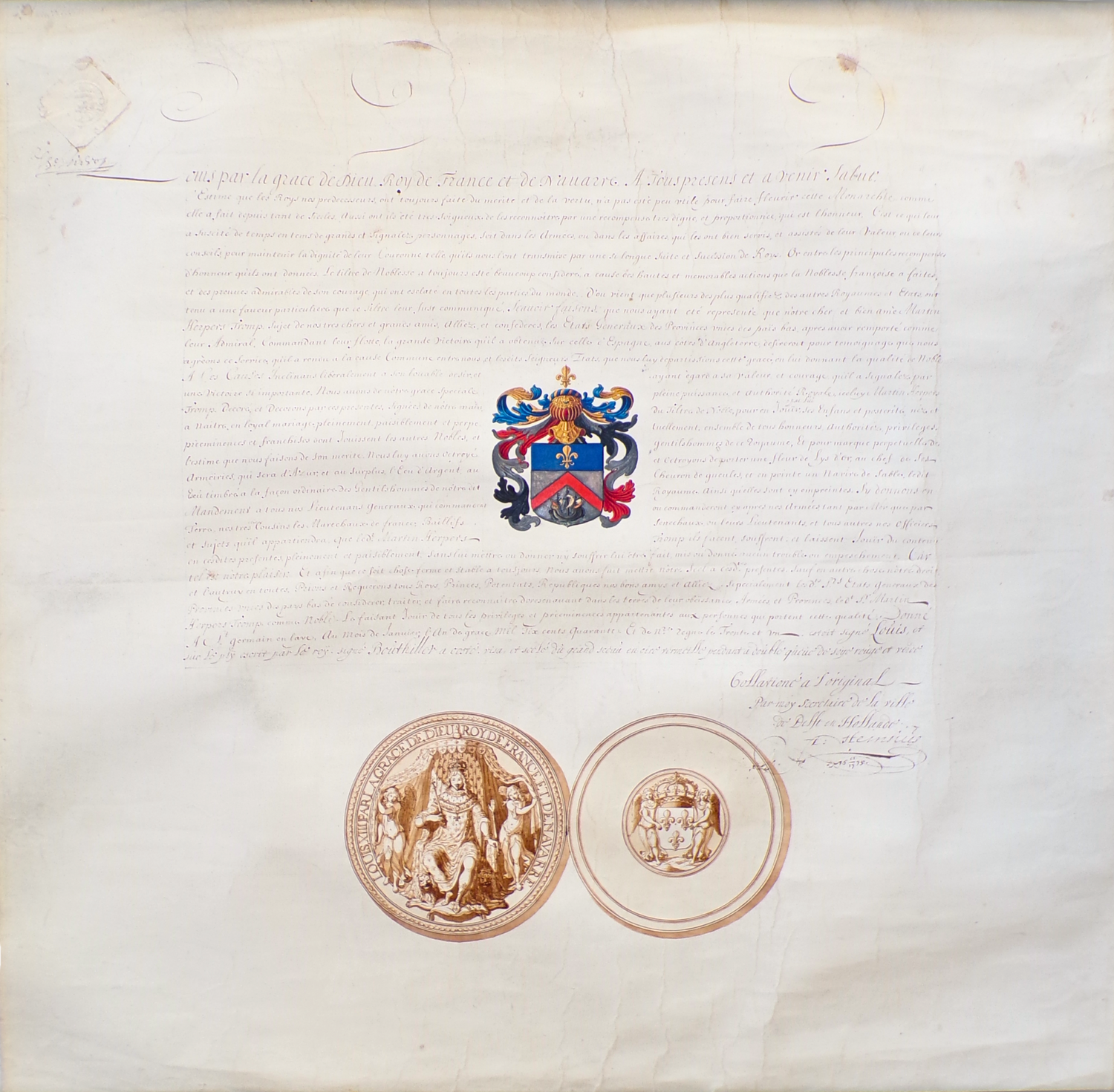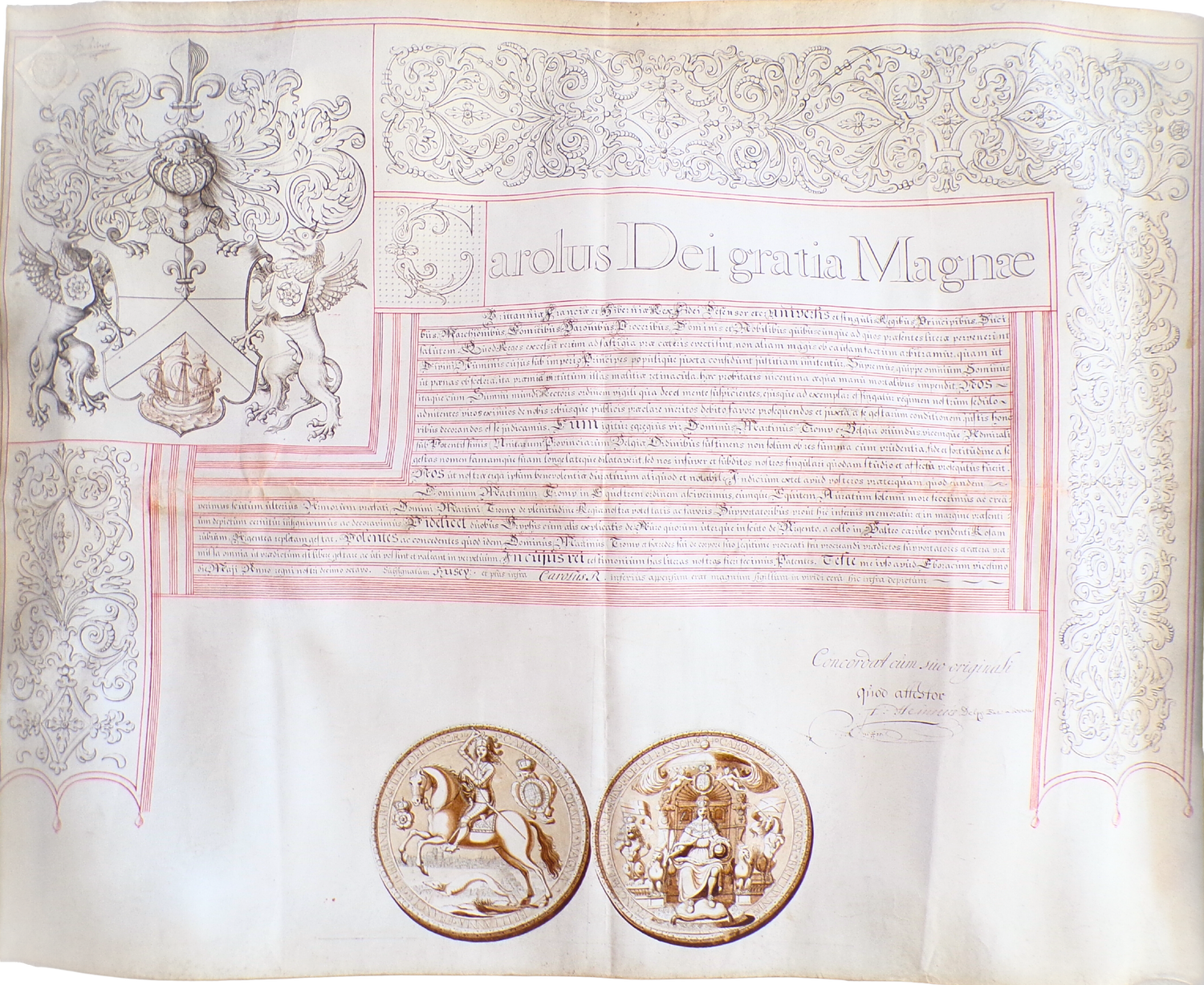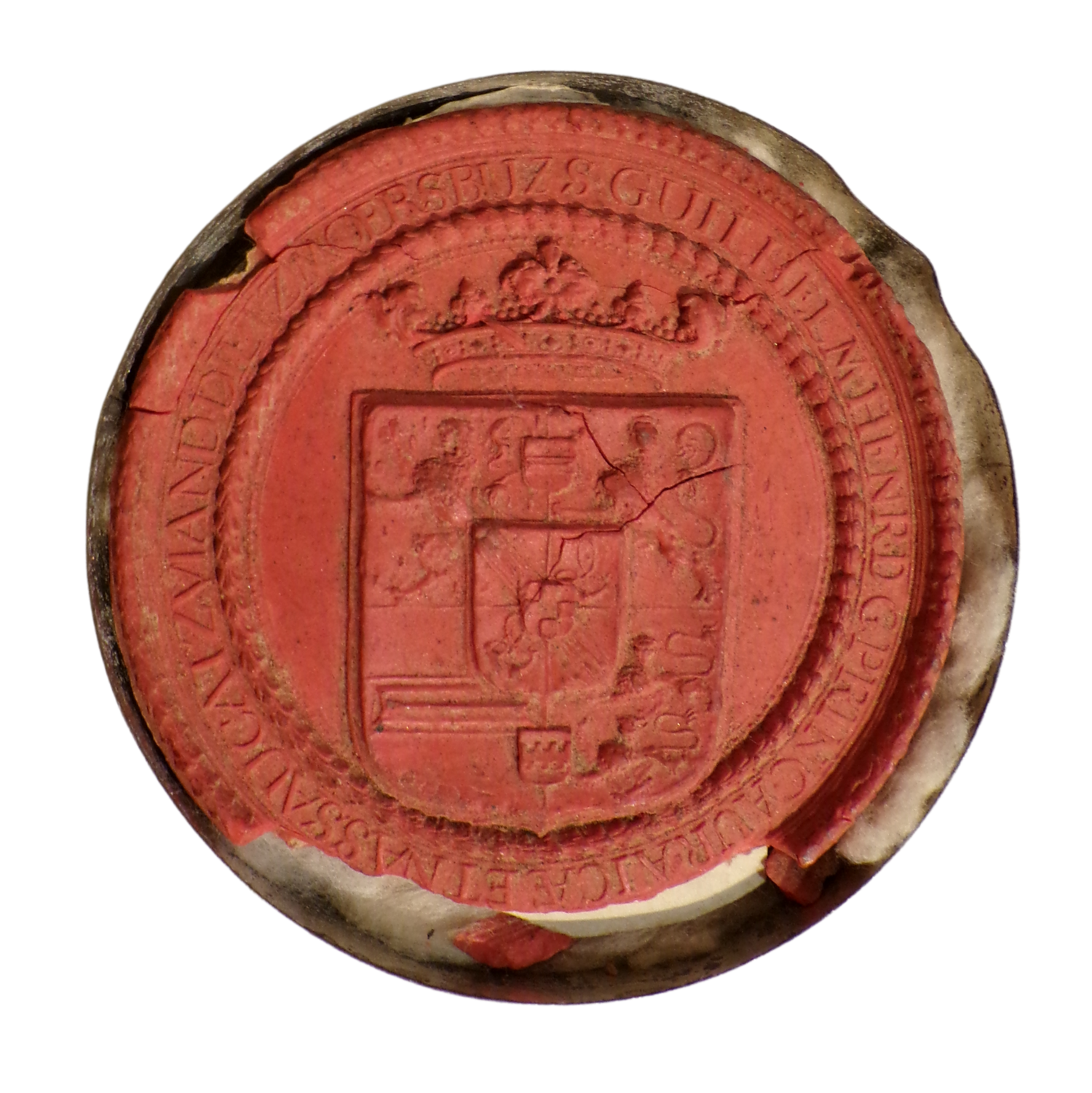Admiral Cornelis Tromp's collection of Letters of Nobility (1676)
- Regular price
- €29.000,00 EUR
- Regular price
-
- Sale price
- €29.000,00 EUR
- Unit price
- per
1. Letter of Nobility by Danish King Christian V to Admiral Cornelis Tromp.
Denmark, 1676.
[With]:
2. Copy of the Ennoblement Document of Maarten Tromp by Louis XIII of France (1640).
Delft 1675.
3. Copy of the Patent of Knighthood to Maarten Tromp by Charles I of England (1642).
Delft 1675.
4. Copy of the Ennoblement Document of Maarten Tromp by Louis XIII of France (1640)
Amsterdam, 1788.
5. The Seal of William Henry, Prince of Orange (Later King William III of England).
Ca. 1676.
An exceptional collection of the ennoblement documents of Admiral Cornelis Tromp, centered around his Letter of Nobility from the Danish King Christian V granted in 1676, accompanied by copies of his father's - and fellow Admiral - two nobility documents, made in the same year. This collection was likely compiled and issued in its entirety to Cornelis Tromp by Stadholder-Prince William III upon his elevation to Count of Sylliesborg by the Danish King. The Danish letter of nobility within the collection is the original. The remaining three are copies made in Delft in 1675 of letters originally granted to Maarten Tromp by the monarchs of France and England. These were signed by the city secretary of Delft, Anthonie Heinsius. Included with the collection is a single wax seal of Stadholder-Prince William III, bearing the coat of arms he used in 1675. This seal is not affixed to any of the letters but may have served as an independent means of authentication when Cornelis Tromp received the documents. The collection appears to have functioned as a formal consolidation of the Tromp family's noble status, bringing together recognition from multiple European powers in a single, curated assemblage. It was later inherited by the Van Kinschot family, into which the Tromp family was absorbed.
In the Dutch Republic, admirals were the ultimate heroes and few attained greater renown than Maarten Tromp and his son Cornelis Tromp. While military leaders in monarchies were often ennobled by their own sovereigns, Dutch society was largely governed by a mercantile elite, and formal ennoblement was virtually impossible. Therefore it was an exceptional distinction for a Dutch citizen to be elevated to the nobility by foreign rulers, signalling not only personal achievement but also international recognition of the Republic’s growing influence. As such, these four Letters of Nobility were of immense social value, marking the Tromps' transition from celebrated naval commanders to recognized members of European aristocracy.
1. Letter of Nobility for Cornelis Tromp Creating Him Count of Sylliesborg (1676)
Calligraphic Danish in gilt and ink on vellum (44.5 cm x 79.4 cm), with gilt ornamental marginal decorations, the coat of arms of the Count of Sylliesborg hand-drawn in colour in the center, and the signature of Christian V of Denmark. No seal present.
This Letter of Nobility was issued by King Christian V of Denmark on December 3, 1676, officially elevating Cornelis Tromp to the rank of Count of Sylliesborg (Sölvesborg). The ennoblement was a reward for Tromp’s service as supreme commander of the Danish fleet during the Scanian War. Following the death of Admiral Koert Adelaer in 1675, Tromp assumed command of the Danish navy on May 8, 1676. His leadership proved instrumental in securing Danish victories, including his triumph over the Swedish fleet at the Battle of Öland on June 11, 1676, and the recapture of Ystad on July 7, 1676. In recognition of his successes, Tromp was knighted into the prestigious Order of the Elephant and was later granted the noble title of Count of Sylliesborg by Christian V.
After his tenure in Denmark, Tromp briefly returned to the Dutch Republic in 1677 and was eventually dismissed from Danish service in May 1678. His appointment as Lieutenant Admiral-General of the Dutch fleet followed in 1679. Tromp’s noble title carried significant prestige, and upon his return to the Republic, he named his estate in 's-Graveland ‘Syllisburgh’ after his Danish countship.
2. 1675 copy of the Ennoblement document of Maarten Tromp by Louis XIII of France (1640).
Calligraphic French in ink on vellum (69.2 cm x 88.9 cm), with the arms of Maarten Tromp drawn and colored by hand in ink and gouache; with the seal of Louis XIII drawn by hand in ink; signed by hand in ink by Anthonie Heinsius, city Secretary of Delft "A. Heinsius 16-8/17-75".
This document was issued to Maarten Tromp by King Louis XIII of France on January 13, 1640, and later verified in Delft on August 17, 1675, by city secretary Anthonie Heinsius (1641-1720). It features Tromp’s newly designed coat of arms, surmounted by the golden fleur-de-lis.
This Patent of Knighthood was issued to Maarten Tromp by King Louis XIII of France on January 13, 1640, and later verified in Delft on August 17, 1675, by city secretary Anthonie Heinsius. The document is written in calligraphic French on vellum and features Tromp’s newly designed coat of arms, surmounted by the golden fleur-de-lis. The coat of arms is drawn and coloured by hand in ink and gouache, with the seal of Louis XIII meticulously rendered in ink rather than affixed. The document bears the signature of Louis XIII and was later signed in Delft by Heinsius as part of an official verification process.
3. 1675 copy of the Patent of Knighthood to Maarten Tromp by Charles I of England (1642)
Calligraphic Latin in ink on vellum (62.9 cm x 62.9 cm), with rubricated lines, with the arms of Tromp in canton, with rinceaux banding. With the ink seal of Charles I in base. Signed "A. Heinsius 16-8/17-75".
This Patent of Knighthood was issued to Maarten Tromp by King Charles I of England in 1642 and later verified in Delft on 17 May 1675 by Delft city secretary Anthonie Heinsius.
Tromp received this honour in recognition of his close ties to the English crown and his distinguished naval service. In 1642, during the early years of the English Civil War, he was tasked with escorting Queen Henrietta Maria of France and Princess Mary Henrietta of Orange from England to the safety of the Dutch Republic. His loyalty and ability to navigate the political tensions of the time earned him great respect among the English elite. Between 1641 and 1643, he was repeatedly called upon to accompany members of the English royal family across the North Sea, further strengthening his reputation. His English knighthood is also reflected in his coat of arms, where the griffins flanking the shield were a direct grant from Charles I, symbolising Tromp’s distinguished status within both English and Dutch circles.
4. 1788 copy of the Ennoblement Document of Maarten Tromp by Louis XIII of France (1640)
Calligraphic French in ink on vellum (69.2 cm x 88.9 cm), with the arms of Maarten Tromp drawn and coloured by hand in ink and gouache; with the seal of Louis XIII drawn by hand in ink; signed by hand in ink by Anthonie Heinsius in Delft "A. Heinsius 16-8/17-75"; signed by hand in ink by Hendrik Huijghens (1755-1838), Secretary of the city of Amsterdam, dated "VI December 1788", “copia” written in ink in the top left.
Tromp's elevation to the French nobility followed his decisive victory at the Battle of the Downs in October 1639, where he destroyed a powerful Spanish fleet and secured a major strategic triumph for the Dutch Republic. This victory elevated his status both domestically and internationally, earning him admiration throughout Europe. In response, Louis XIII, an ally of the Dutch, not only granted Tromp knighthood in the prestigious Order of Saint Michael but also ennobled him.
5. The Seal of William Henry, Prince of Orange (Later King William III of England)
Vermillion wax in its tin skippet, the latter with a paper label identifying it as preserved with the Letters of Nobility of M. Tromp and the name M. van Kinschot. Diameter: 11.5 cm, Height: 2.5 cm.
Condition: In very good general condition. Kept in a 19th(?) century wooden case. Seal partially broken.
Provenance: M. van Kinschot, Netherlands; The Estate of Ellis Sidney Joubert III, New Orleans.
Sources
Nationaal Archief, 1.11.01.01, inv. nr. 738.1-738.3
Museum Prinsenhof Delft, collectie 106143, 106162
· Nederlandsch archievenblad, 1897/1898, no 3. Consulted on Delpher 21-02-2025, https://resolver.kb.nl/resolve?urn=dts:932004:mpeg21:0001
Couldn't load pickup availability
Share
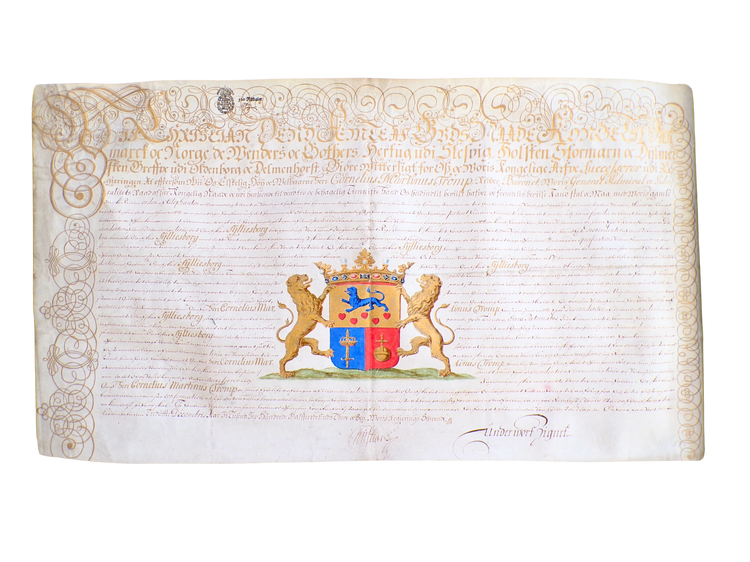
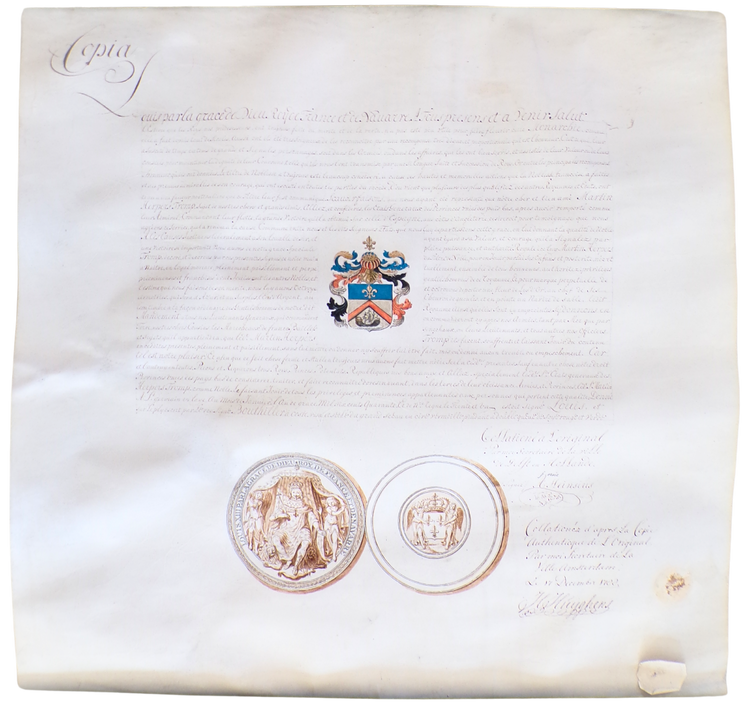
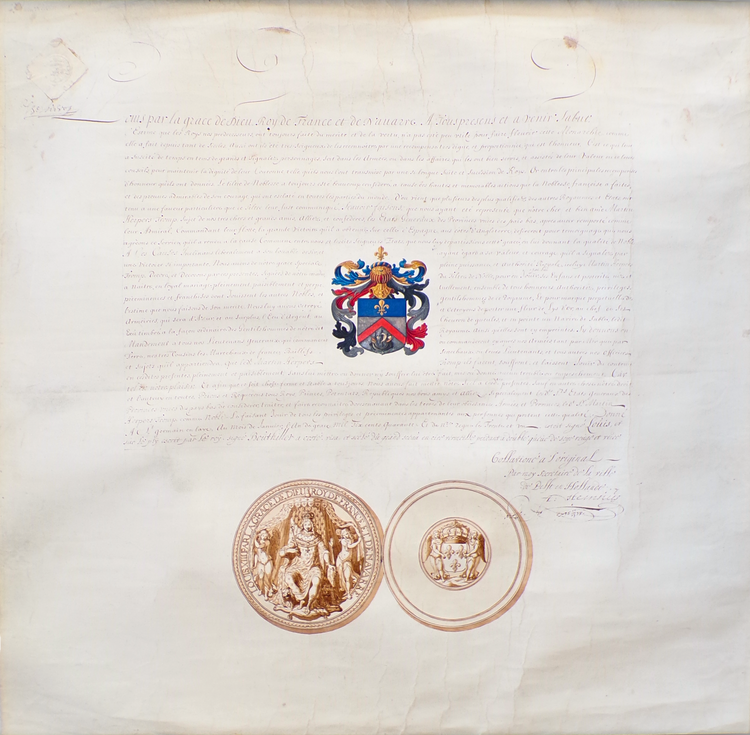
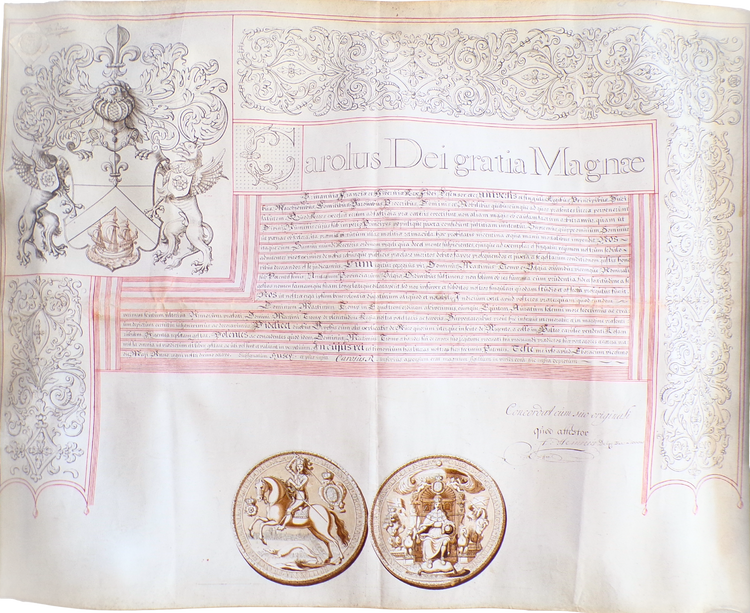
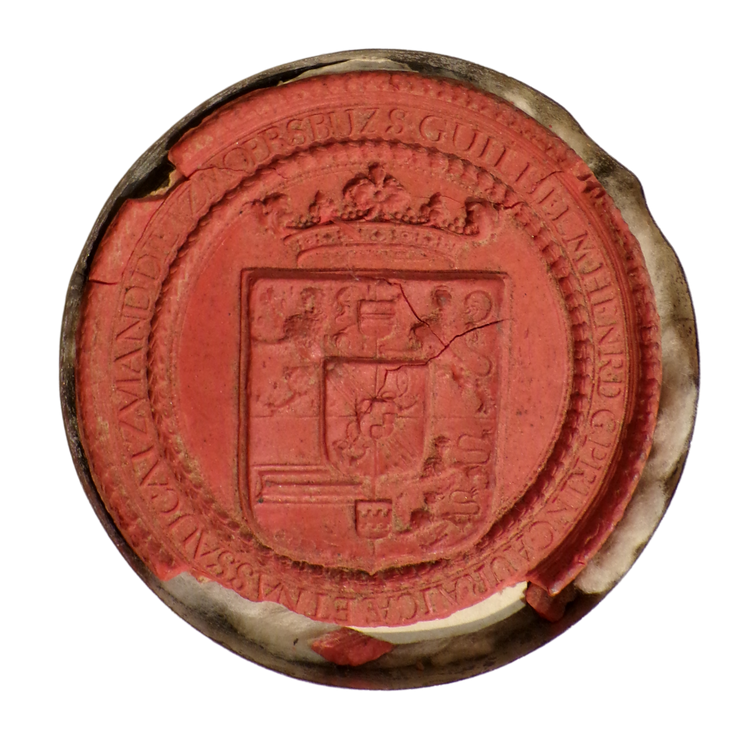
Contact
Email: hugo@artemrarebooks.com
Phone: +31651042297
Visit us on appointment at:
Former US Embassy
Lange Voorhout 102
2514EJ
The Hague (The Netherlands)
Shipping address:
Nannie van Wehlstraat 51
2548MN
The Hague
The Netherlands

